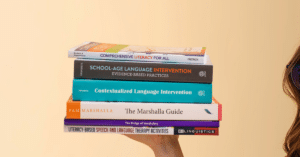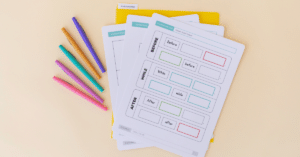Listen on Apple Podcasts Listen on Spotify
Want to hear more about this topic? Click here for all things scaffolding!
This Week’s Episode: Interactive Scaffolds
In the first two parts of this month’s learning series, we talked about setting the stage for scaffolding, and structural scaffold.
Now we are jumping into interactive scaffolds!
In this episode I break down the three sub-types of interactive scaffolding, which are intended to facilitate students’ responses, maintain engagement, and encourage concept accuracy.
Sounds like an SLP’s dream. 🥰
Now, we didn’t have time to dive into all the different strategies for each specific skill, but you’ll definitely walk away with an introduction to the basics — then you can go down your own research rabbithole about all things scaffolding!
Links Mentioned
– ReadWorks Article: Conquering Phobias
– SLP Now Membership (Graphic Organizer included in membership)
– Literacy-Based Therapy Cheat Sheet
Subscribe & Review in iTunes
Are you subscribed to the podcast? If you’re not, subscribe today to get the latest episodes sent directly to you! Click here to make your listening experience auto-magic and as easy as possible.
Bonus points if you leave us a review over on iTunes → Those reviews help other SLPs find the podcast, and I love reading your feedback! Just click here to review, select “Ratings and Reviews,” “Write a Review,” and let me know what your favorite part of the podcast is.
Thanks so much!
Transcript
Okay, so now onto interactive scaffolds. These are reactive. So interactive, reactive. The structural scaffolds are things that we plan ahead of time. Then, the interactive ones are things that we do in the moment. It's when we respond to what's happening in the session. The cool thing is, if we have the structural scaffolds in place, we'll have a lot more cognitive capacity. Especially as a newer SLP, we'll have a lot more resources available to us to be reactive and provide those scaffolds in the moment because we won't have to be worrying about the general structure. That'll already be taken care of. We can really focus on the students and providing them with what they need.
Now, we'll dive into the three types. The first one is a response, interactive scaffold. This is intended to facilitate students' responses. The cool thing is that we automatically end up doing a lot of these things. After I started grad school, I found myself using a lot of these scaffolds with my students, and just even with strangers. With response facilitation, we want to encourage our students to provide a response as we work towards their goals. Then, we can be aware of the different response facilitation.
Here are some things that we can do. If we're working on producing past tense verbs in sentences, or if we're summarizing a passage, we can use some of these different response facilitation. We can give a model. If we're working on producing past tense verbs, we model, model, model, model those past tense verbs, or we can provide part of the answer. If we're doing those past tense verbs, again, we can say, "The student err..." just to give them... That may or may not be helpful, but for some students that might work, or if we're creating a summary, I might give them visual choices, which gives them part of the answer, or I might give them one of the answers, and they have to find the other ones.
We can ask leading questions. If we're trying to fill in the summarizing organizer, and if it's a passage about... What did we have for this month? Conquering phobias. If one of the statements on the organizer is, "Rats are scary." One of the leading questions we can ask is, "Is that relevant?" or "Does that have to do with the main idea?" That's just one example of something we could do.
We could point to a visual. We could point to the organizer, and we can point to the visual. That breaks down the skill if they're stuck on a certain step. Then, we can also repeat and emphasize key points to lead the child to write the answer. So lots of options there.
Like I said, I think these are all things that we automatically do, but I think it's a helpful refresher, too, if we are feeling stuck. We know how to do all of these things. It's just a matter of being like, "Okay, I'm stuck. I'm going to try some of these things."
The next type is regulatory. These are intended to maintain student engagement. If a student is not engaged, they will not be learning, and they won't be making progress towards their goals. Some things that we can do are that we can review their goals. We can talk about just what they are and why they matter. That makes a huge difference. I used to struggle to keep students motivated. I mean, I can keep any kid motivated with a game, for the most part, but I had a lot more success once I started really talking about their goals and targeting their goals in meaningful contexts. It's really cool to see how students step up when given that context.
Some other things we can do are really content to pass knowledge. This is something that we do a lot of in step one of the literacy-based therapy framework, but we can also do that if we're starting to lose them. We can reel them in and talk about how it's related to something going on for them now. We can comment on student performance and giving specific feedback. It can be incredibly helpful. Then, just providing redirection. If they're looking off or if they're starting to fall asleep, we could just redirect that behavior.
This is a really great opportunity to incorporate some growth mindset. I've seen that work really well for my students, too, especially because a lot of our students really struggle in the classroom, especially in the older grades. School's not easy for them because of their speech and language delays. They have to work extra, extra hard to be able to even just keep up. I think praising their effort is incredibly meaningful because that'll... I've seen some students with really great growth mindset. It's just amazing to see what they can accomplish. If we can share that with our students, that is just super amazing.
The last type of interactive scaffolding is linguistic. This is intended to encourage concept accuracy. The goal of this is to help our students nail down the concept accurately. Once they provide a response, we can support their learning by providing a model. That would be more ahead of time. If we see them struggling, we can give them that model. We can do expansions and recasts, where we add to what the student is saying. So if the student says, "He run," we could say, "He is running." We would add the "is" and the I-N-G at the end.
We can do focused contrast, where we demonstrate the error and the correct target side-by-side. So if we're doing grammar, we can say, "Oh, I heard he run. Is it he run, or he is running?" That can be a focused contrast. We can also do that with the summarizing examples. I'll show you what the graphic organizer looks like in the later unit. But we can look at it and put one answer on the organizer, and then switch it out for another one and have them look and see which one is correct and which one's not correct and have that focused contrast. Then, we can also do vertical structuring where we ask a student to provide more information, and then combine the responses to reach their target. Those are just a couple of things that we can do. It's not a comprehensive list, but those are some great strategies. If we ever have someone observe, we can list those different things that we're... We can use some of those fancy vertical structuring to show what we're working on.
We don't have time to dive into all of the different strategies for the specific skills, but there's really cool research out there, especially when it comes to grammar. It talks about how to structure, when do you use certain supports, and when to pull in other ones, and just the progression there. It's been super, super cool to see that all come together, but that'll be another time.
Then, some other things that we can do, we can have peer models. That's one of the beautiful things about mixed groups. I personally love mixed groups because it gives students opportunities to demonstrate their strengths and also see other students modeling their targets. Then, another thing we can do is reciprocal teaching. It's an instructional activity in which students become the teacher. I think it came from small group reading research, but the processes where the teacher or the SLP models, and then the student... It helps the students learn how to guide the group discussion and moving along there. But I think just it boils down to giving students opportunity to teach concepts, which I know that works really well for me.
Sign up to receive email updates
Enter your name and email address below and I'll send you periodic updates about the podcast.




Reader Interactions